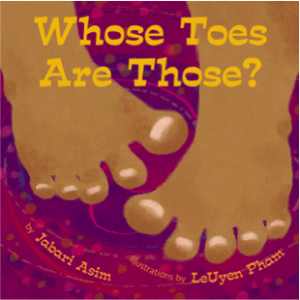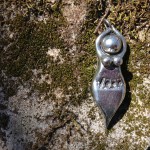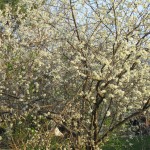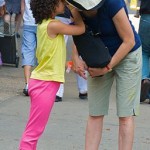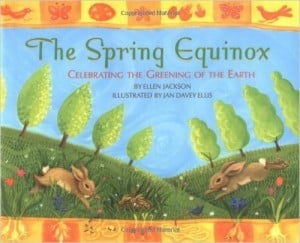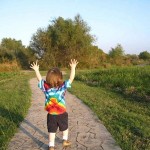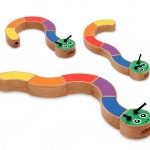By Meg Yardley
Beltane, or May Day, celebrates the fertility of the earth, the diversity of our community, and the joys of living in a body. Traditions for this holiday that are especially fun with children including gathering flowers to make wreaths and garlands; getting up at dawn to bathe your face in the dew; and dancing the Maypole. Here are some recipes for May Day, and I also love this piece on “How to celebrate Beltane with a 4-year-old”.
In honor of Beltane, you may want to seek out books related to:
- Celebrating the body – For adults, Beltane is often a time to celebrate sexuality and relationships. We can help young children to develop a positive foundation for later relationships by teaching them to celebrate and care for their bodies. For toddlers, books naming parts of the body (a la “Head, Shoulders, Knees, and Toes”) can be a great start. For older children who are ready to learn age-appropriate material about body development, I like “It’s Not the Stork: A Book About Girls, Boys, Babies, Bodies, Families and Friends” by Robie Harris and Michael Emberley, which is full of funny cartoons and straightforward, accurate information.
- Flowers – Making flower wreaths and garlands is a traditional May Day activity, so any books celebrating flowers would fit beautifully.
- Rainbows – The rainbow-colored ribbons of the Maypole represent the bright colors of spring and (according to Starhawk’s wonderful story in “Circle Round”) the wide range of all forms of love.
- Love – It doesn’t have to be romantic love – this is a great holiday to celebrate the wonder of all our human connections.
- Diversity – Books that recognize and celebrate our differences (physical and otherwise) are wonderful to share this time of year. There are a number of books on appreciating different skin colors (see here for more on why talking about skin color is important, especially for white parents), and a few are reviewed on this page. My vote is for “The Colors of Us” by Karen Katz, which, although not perfect, engaged my preschooler’s attention more than other books on this topic because it feels more like a story. “Bein’ With You This Way” by W. Nikola-Lisa, and “Whoever You Are” by Mem Fox are also sweet books that address difference more broadly. You may also want to seek out books that honor different kinds of families.
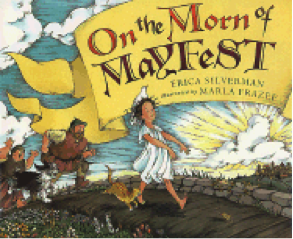 On the Morn of Mayfest, by Erica Silverman, illustrated by Marla Frazee
On the Morn of Mayfest, by Erica Silverman, illustrated by Marla Frazee
This cumulative story (a la “The House that Jack Built”) begins about a lass “with hair like a nest” who walks in her sleep on the morning of Mayfest, attracting a bird, a cat who chases the bird, a dog who chases the cat, and so on… leading up to the town’s May Day parade. Although the wording can be a little clunky at times, it has a good rhythm and a fun celebratory mood. For older toddlers and up.
Pagan Notes: This story ends up with everyone kissing each other (including some animals) and then celebrating May Day with flowers and dancing. The image of the girl sleep-walking on May Day morning brings to mind traditions of getting up at dawn on May Day to bathe in the dew or to gather and give out flowers.
The Rainbow Tulip, by Pat Mora, illustrated by Elizabeth Sayles
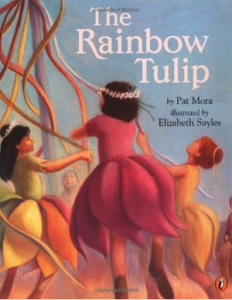 At home, Estelita enjoys a warm life with her Mexican immigrant family; at school (where she is called Stella), she sometimes feels ashamed that her mother is different from the other mothers and can’t speak English to communicate with the teacher. When her aunt makes her a rainbow tulip costume for the school May Day parade, she faces a choice between shame and pride in being herself. This book, based on a story from the author’s mother’s childhood, offers a gentle, character-driven exploration of assimilation and difference. As in Grace Lin’s “The Ugly Vegetables,” the main character’s obstacles are primarily in her own mind and she doesn’t face a lot of outward prejudice. For older preschoolers and up; it’s fairly wordy and the action is slower-paced.
At home, Estelita enjoys a warm life with her Mexican immigrant family; at school (where she is called Stella), she sometimes feels ashamed that her mother is different from the other mothers and can’t speak English to communicate with the teacher. When her aunt makes her a rainbow tulip costume for the school May Day parade, she faces a choice between shame and pride in being herself. This book, based on a story from the author’s mother’s childhood, offers a gentle, character-driven exploration of assimilation and difference. As in Grace Lin’s “The Ugly Vegetables,” the main character’s obstacles are primarily in her own mind and she doesn’t face a lot of outward prejudice. For older preschoolers and up; it’s fairly wordy and the action is slower-paced.
Pagan Notes: Beltane is a wonderful holiday for celebrating diversity and difference, and this book speaks honestly to some experiences of difference (the character’s mother says that being different “is sweet and sour, like lime sherbet”). I will note that although the May Day parade is a focal point of the book, the Maypole itself only has a couple of pages – too bad, since the pictures of it are so pretty! But this book might get your child excited about the Maypole.
Whose Knees are These? and Whose Toes Are Those?, by Jabari Asim, illustrated by LeUyen Pham
This pair of adorable board books by writer and cultural critic Jabari Asim celebrate the body and the person in it. The colorful illustrations of knees and toes (respectively) convey joy and action, paired with playful rhyming text leading up to the eventual revealing of the whole child. “Whose knees are these?/ Knees like these/ don’t grow on trees./ So brown and so strong,/ to whom do these fine knees belong?”
Pagan Notes: Many books for toddlers and young children celebrate the body as a place of joy and pride. This is a wonderful message to send to our children at Beltane, when we honor the sacred experience of our physical bodies.
Octopus Hug, by Laurence Pringle, illustrated by Kate Salley Palmer
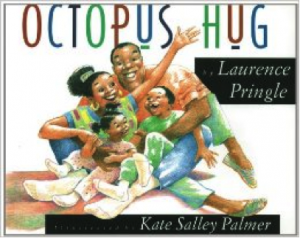 In this sweet family story, a young brother and sister feel cranky when their mom goes out for the evening, but their dad cheers them up with a series of silly, rough-and-tumble games (like the “octopus hug”). The illustrations have a lively, almost cartoonish quality which evokes the energy and excitement of the family’s antics. As you read through the procession of games, you may find yourself jumping up to try some of them with your children! For preschoolers and up.
In this sweet family story, a young brother and sister feel cranky when their mom goes out for the evening, but their dad cheers them up with a series of silly, rough-and-tumble games (like the “octopus hug”). The illustrations have a lively, almost cartoonish quality which evokes the energy and excitement of the family’s antics. As you read through the procession of games, you may find yourself jumping up to try some of them with your children! For preschoolers and up.
Pagan Notes: Children learn to appreciate their bodies through the positive bodily experience of physical play. (Also, the book shows how the children and parent move together through cycles of excitement and rest, which can develop children’s capacity to regulate their emotions.) Another Pagan story with a similar theme is the Beltane chapter of “Aisha’s Moonlit Walk” (by Anika Stafford), in which Aisha and her best friend are at the beach for a Beltane ritual and celebrate by covering themselves with seaweed and wrestling in the sand.
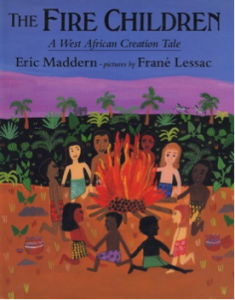 The Fire Children: A West African Creation Tale, by Eric Maddern, illustrated by Frane Lessac
The Fire Children: A West African Creation Tale, by Eric Maddern, illustrated by Frane Lessac
In this retelling of a creation story from the Akan culture in West Africa, two spirit people are accidentally sneezed out onto Earth by Nyame, the sky god. Living on Earth, they become bored and decide to create some little people out of clay and bake them in the fire. However, Nyame keeps showing up for surprise visits and they have to pull the little people out of the fire to keep them hidden. The batches get baked for different lengths of time, which explains why some people’s skins are pale or pinkish, others are reddish brown, and others are dusty black. This story is illustrated with wonderful, fun paintings, and ends with a map of the world showing little figures with a range of skin tones living all over the world. For preschoolers and up.
Pagan Notes: This is a fun creation story and offers a lighthearted explanation for the origin of different skin colors – a wonderful way to introduce the topic to children. It ends: “And that is why today the Earth is filled with people of many different colors – black, white, red, brown, yellow, and pink. Aso Yaa and Kwaku Ananse love them still. They always will.”
“May Day/ Lei Day”, photographs by Minako Ishii, written by Jeffrey Kent 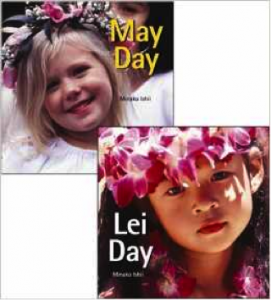
This two-in-one flip book traces the connection between traditional English May Day celebrations and Hawaii’s Lei Day celebration. The book “May Day” tells about England and Hawaii’s customs, describing English May Day and how it was adopted in Hawaii as the festive, flower-oriented Lei Day. On the reverse side, the book “Lei Day” explains the meanings of different flowers used in leis (which represent Hawaii’s different islands) and also describes how to make your own lei (did you know that they can also include seashells, leaves, berries, and other natural materials?). Both books are illustrated with gorgeous, full-color photographs. The text is oriented more toward older children, but the bright photos (and the book’s smaller size) will appeal to younger children as well, and you can easily simplify the words for them.
Pagan Notes: A wonderful example of a custom being adapted cross-culturally into the new culture’s idiom. The photos in this book include both Native Hawaiian and white(-appearing) children and adults, and the text includes Hawaiian words and concepts. I will add that when I read references to “Hawaii’s royal history,” I couldn’t help but remember that Hawaii’s royalty was overthrown by Euro-Americans for the sake of financial interests. It’s not easy to treat this kind of history honestly in a children’s book, and I know a truthful historical account would have marred the cheerful tone of the book, but nonetheless I felt some discomfort about the historical context. That aside… this is a wonderful read for May Day and be ready to make some flower magic with your children after reading it!
The Marriage of the Rain Goddess, by Margaret Olivia Wolfson, illustrated by Clifford Alexander Parms 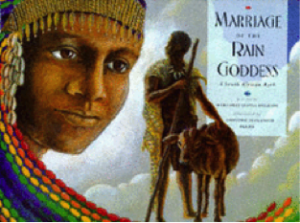
In this retelling of a Zulu tale from South Africa, the rain Goddess, Mbaba Mwana Waresa, is looking for a husband who is worthy of her. She finds a shepherd who seems perfect but decides she must test him to determine whether he is truly the right one. She disguises herself with ashes and rags, and presents a beautifully dressed young woman to the shepherd as Mbaba Mwana Waresa. The shepherd looks into the real Mbaba Mwana Waresa’s eyes and recognizes her for who she is; his perceptiveness proves he is worthy to be her husband. The illustrations make use of a rainbow motif and also depict some beading used by girls of the Zulu culture to express feelings of love. For older preschoolers and up. (The theme of romantic love may not interest your younger preschooler much.)
Pagan Notes: Romantic love may not be the theme of Beltane that we emphasize most with young children, but this is a sweet depiction of a love where people can see each other for who they really are. I can’t speak to the authenticity of this retelling, but I appreciated that it’s a story about romantic love where the woman is powerful (being a goddess) and has plenty of agency in the process (rather than waiting for a suitor to come to her). The rainbow motif also fits well with a Beltane/ May Day theme.
Meg Yardley is a Pagan and a parent of two young children, living in the San Francisco Bay Area. She sings with the Turning Earth Singers, a Pagan music ensemble which recently led a “Pagan Kids’ Song and Story Time” workshop. She appreciates pictures books as a wonderful spiritual practice parents and young children can share.
Editor’s Note: You can find books reviewed at Pagan Families in our Amazon store.


